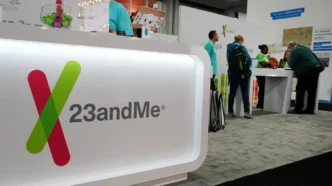23andMe, once a trailblazer in the consumer DNA testing market, has filed for Chapter 11 bankruptcy protection after years of financial missteps and mounting competition. The Silicon Valley startup, which peaked at a $6 billion valuation following its 2021 SPAC debut, has seen its market value plunge to just $50 million by early 2025. Today, its shares trade for less than $1, signaling the fall of a pioneer that once promised to reshape personalized healthcare.
How 23andMe Started Strong with a Bold Vision
Founded in 2006 by Anne Wojcicki, Linda Avey, and Paul Cusenza, 23andMe set out to make genetic information accessible to everyone. Their mission was clear — empower people with insights about their health, ancestry, and DNA traits.
Anne Wojcicki, a Yale-educated biologist and former healthcare analyst, led the charge. As CEO, she guided the company through its public listing and turbulent years until stepping down on March 24, 2025, to launch a bid to buy back the struggling firm.
Linda Avey, with her background in genomics and bioinformatics, helped shape the science behind 23andMe’s tests before leaving in 2009. Paul Cusenza, armed with an MBA from Harvard, laid down the operational groundwork in the early years.
Despite raising over $1 billion in funding, including backing from Google Ventures and Sequoia Capital, 23andMe never managed to break even. Much like DeCode Genetics, which folded in 2009, 23andMe found that monetizing pure consumer genomics was harder than anticipated.
Falling Valuation and Financial Woes Crippled the Company
23andMe’s journey from IPO excitement to bankruptcy highlights the brutal challenges in direct-to-consumer genetic testing. The company went public via a SPAC merger in 2021, raking in $600 million at a $3.5 billion valuation. But the momentum didn’t last.
By 2025, 23andMe’s market cap had plummeted below $300 million. The consumer appetite for DNA kits waned, and efforts to build new revenue streams fell flat. In 2024 alone, the company reported a staggering $285 million net loss, while debts swelled past $500 million. Facing no way out, 23andMe filed for Chapter 11.
In a last-ditch effort, Wojcicki tried to take the company private, offering 40 cents per share. The board rejected the deal, calling it unfair to shareholders. Later that year, the company shut down its drug discovery division and slashed 40% of its workforce to cut costs.
The core problem? 23andMe couldn’t shift from selling one-off DNA kits to building a sustainable healthcare data business. Despite partnerships like its 2018 deal with GSK, the returns were minimal. The genetic database held potential, but converting that into consistent revenue remained elusive.
A Business Model That Failed to Build Long-Term Value
Even with heavyweight investors on board, 23andMe struggled to lock in ongoing revenue. The model was simple — customers bought a kit once, learned about their DNA, and rarely returned. After the initial curiosity, few found reasons to stay engaged.
The GSK partnership was supposed to change that. By tapping into its vast genomic database for drug discovery, 23andMe hoped to carve out a new revenue stream. Early studies showed human genetic data could significantly improve drug development success. Yet, the collaboration never delivered breakthrough drugs or sizable profits.
Adding to its troubles, privacy concerns kept haunting the company. In 2023, those fears turned real. Hackers breached 23andMe’s systems, exposing sensitive data from nearly 7 million users. While only 14,000 accounts were directly compromised, attackers exploited the “DNA Relatives” feature to access a much larger pool of data.
The breach revealed names, birth dates, ethnicities, photos, and family connections, shaking consumer trust. By 2024, 23andMe paid $30 million to settle a class-action lawsuit. California regulators urged customers to delete their data, amplifying the crisis.
Fierce Competition and Shifting Consumer Tastes Sealed Its Fate
While 23andMe was busy firefighting, competitors seized the moment. AncestryDNA expanded its lead in family history services, while MyHeritage won over global users with deeper ancestral insights.
Meanwhile, new players like Helix and Nebula Genomics emerged, offering AI-powered platforms with strict privacy controls — exactly what privacy-conscious customers craved. Others, such as Tempus and Color Genomics, raised the bar by delivering predictive healthcare insights that appealed to hospitals and doctors.
As these rivals evolved, 23andMe struggled to innovate or adapt. Attempts to pivot into healthcare services came too late. Subscription models never gained traction, and the company couldn’t convince users to stick around beyond their initial test results.
What’s Next? The Uncertain Future of Your DNA Data
With bankruptcy now official, Anne Wojcicki has stepped down, though she might return if her acquisition bid succeeds. For now, the company says customers can still access their data and services as it operates under bankruptcy protection.
The big question is what happens to the genetic data 23andMe amassed over nearly two decades. While the company hopes to revive itself as a player in drug discovery and personalized medicine, its future looks shaky. Analysts predict it could soon become a takeover target for biotech giants eager to boost their AI and genomics capabilities.
23andMe’s rise and fall serve as a stark warning. In the crowded DNA testing space, even pioneers can stumble if they fail to innovate, protect user trust, and create lasting value.













